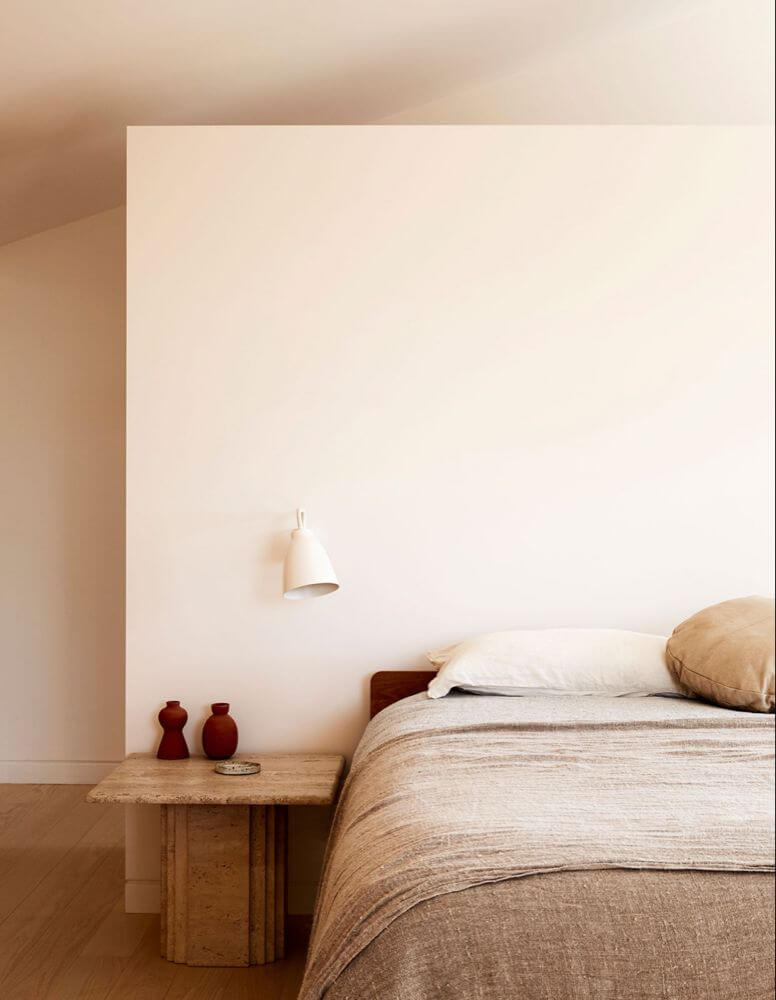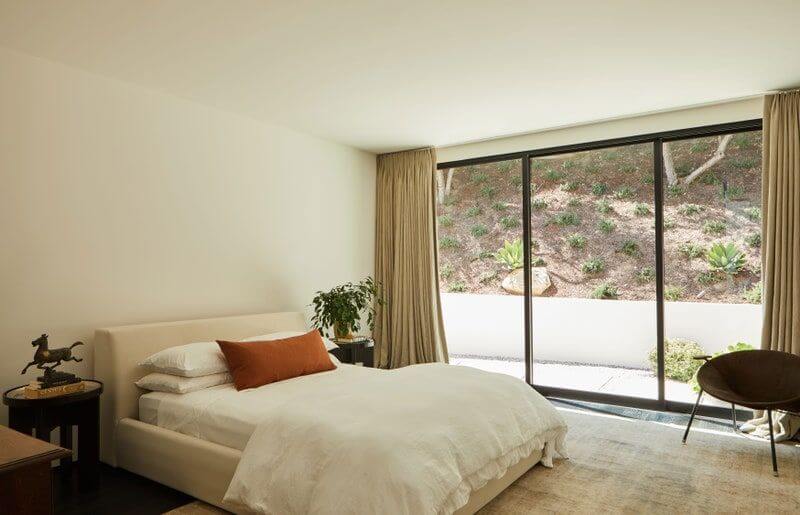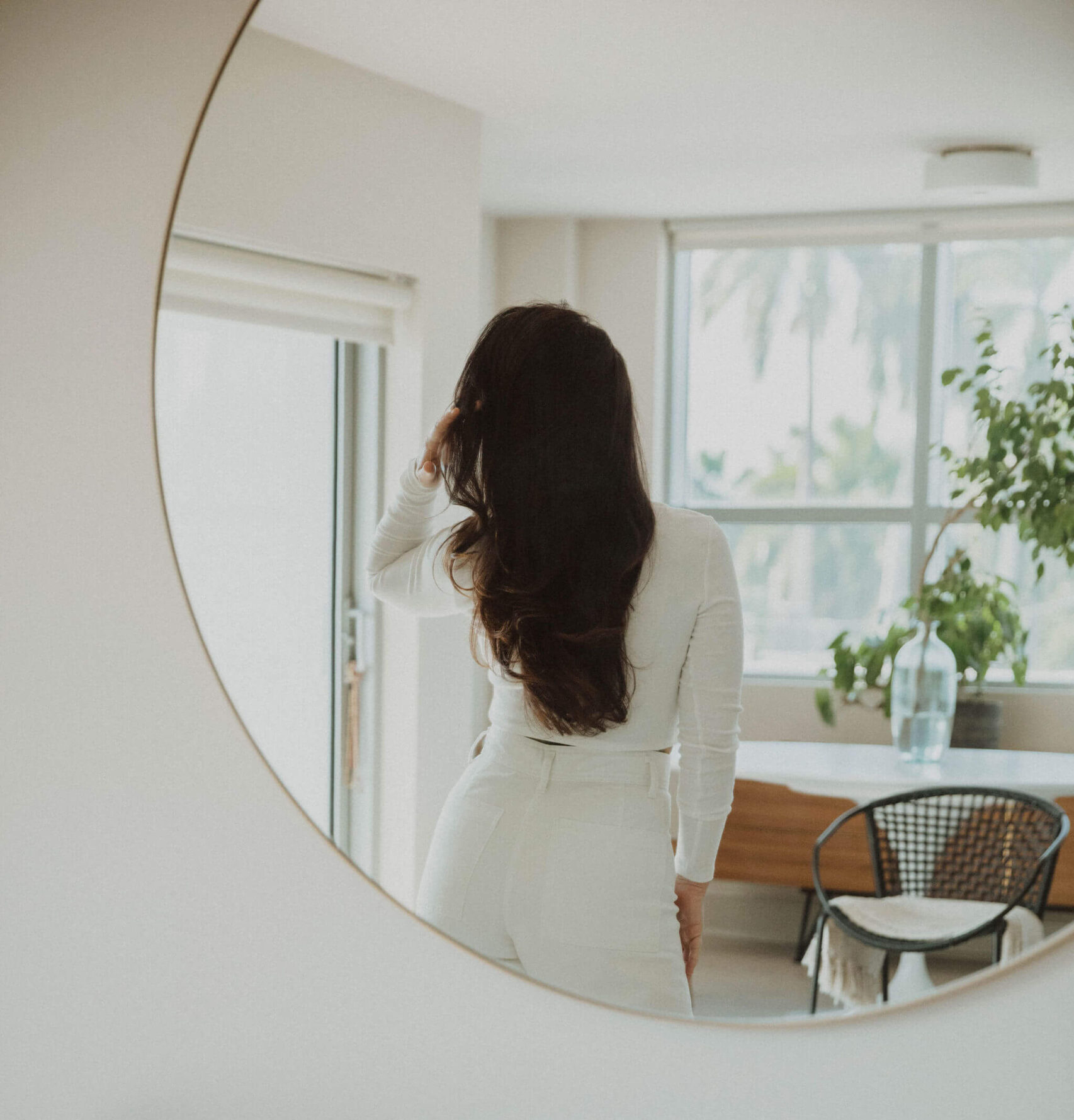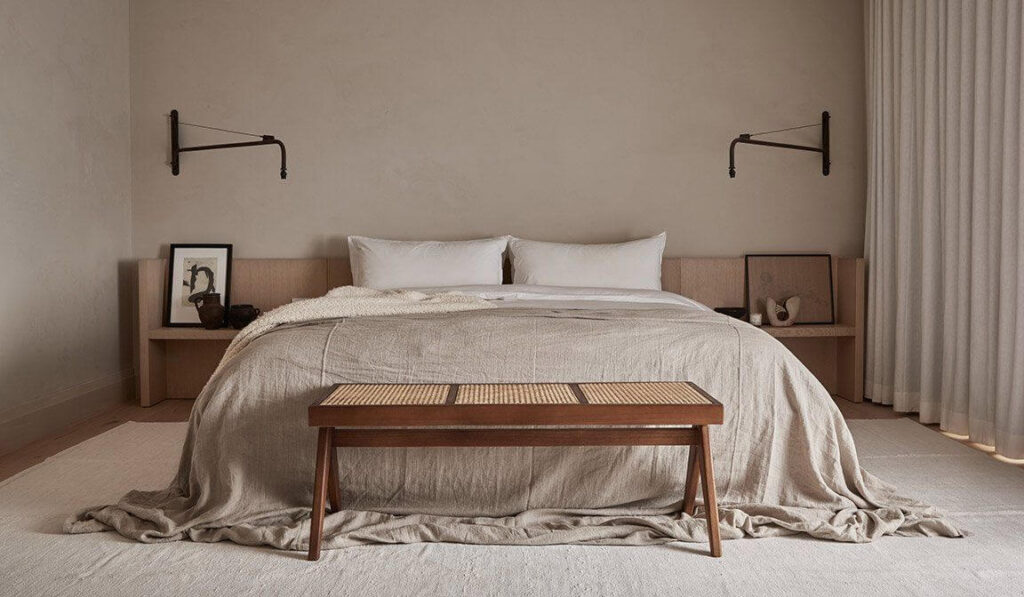
The topic of Minimalism can provoke a multitude of responses. Everything from eye rolls to the belief it is a cold design style to misconceptions that it is some type of depriving lifestyle. It’s certainly a broad term so let’s refine it into simpler terms and discover how we can apply aspects of it to promote an environment of calm, wellbeing, and peace within our homes. I’ve always believed that our spaces and external environments affect the way we feel and there are even studies that reflect this too.
Minimalist design seems to go through trending phases but funny enough, I can remember being in friends’ homes when I was young and conceptualizing how I’d rework and redesign the space if I had the chance. I’d daydream about clearing through what appeared to me as clutter while rebalancing the room through more thoughtful placement of pieces of furniture and getting rid of things that either lacked functionality or overwhelmed the space. The same still holds for me every time I walk into a space and the same principles of simplicity and open space are how I style my own home today.
What is minimalism in relation to design?
Minimalist spaces in no way reflect an empty home or a space void of style. From an esthetic perspective, having a minimalist influence throughout our homes creates quite the statement when combined with tasteful styling and is far from boring. Creating a minimalist-influenced space leaves out the mediocre and lets what is there create visual interest and impact without competing noise. Minimalist design lets the eye relax in a space instead of being overwhelmed by where to look.
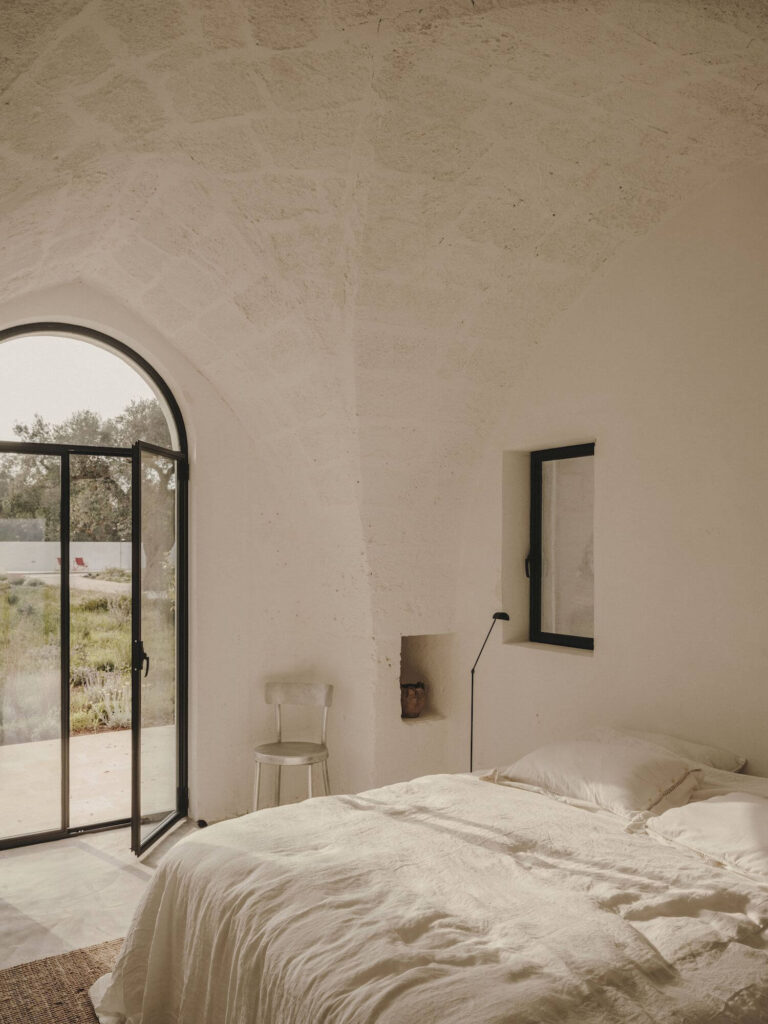
Minimalist interior design often consists of neutral color schemes, open space, a focus on functionality, intentionality, and purpose, and tends to reflect Scandinavian, Nordic, and Danish influences. Minimalist design leans towards the opposite of most traditional American interior design. Interestingly enough, it’s also American culture that tends to lean towards higher consumerism and less intentionality with purchases for our homes and beyond.
Our homes support our wellbeing and should reflect a place to reset and rejuvenate after a long day. A minimalist space represents simplicity, home as an oasis filled with intentionality and a way to detox your home from the unnecessary. I lean towards a soft and warm minimalist approach. Inviting and cozy while free from excess that disrupts energy and harmony flow.
This holds true from a Feng Shui perspective too. One of the most rooted concepts of Feng Shui is that excess clutter imbalances, interrupts and stagnates energy and harmony throughout our homes and lives.
In particular, soft minimalist bedroom decor supports our quality of sleep, rest, and well-being.
It’s much easier to rest when the eye isn’t darting around the room, bedroom furniture is light in weight, we don’t have wires, electronics, and televisions surrounding us or work, bills, and other activating sources in our view when decompressing before we sleep. There are a ton of bedroom ideas and creative tips we can apply to simplify our bedrooms into an intentional and peaceful retreat so let’s dive in!
How To Create A Minimalist Bedroom
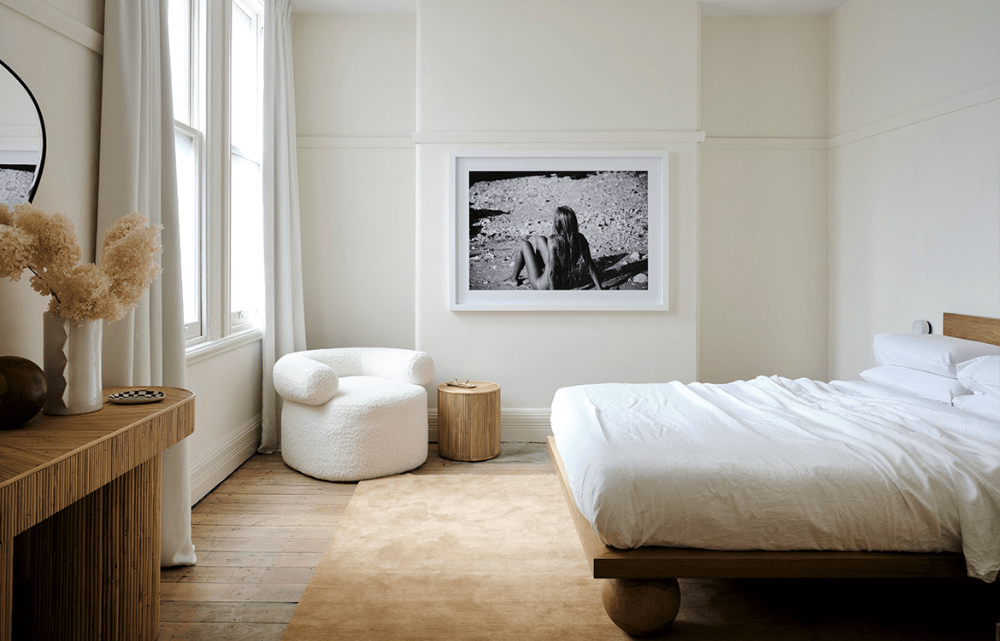
Be Mindful of Purchases
Moving towards more simplicity throughout our homes begins with mindfulness of our purchases. Purchasing items like throw blankets and/or throw pillows just to fill up a room is never a good idea. Spend time exploring the layers of rooms you are drawn to to understand what it is you love about them. Don’t rush the process. This is how decor and design clutter begins to build and we are eventually left unsatisfied with the results. To create a minimalist bedroom, get comfortable with openness. You don’t need much to create a relaxing and calming space as you curate it to your liking.
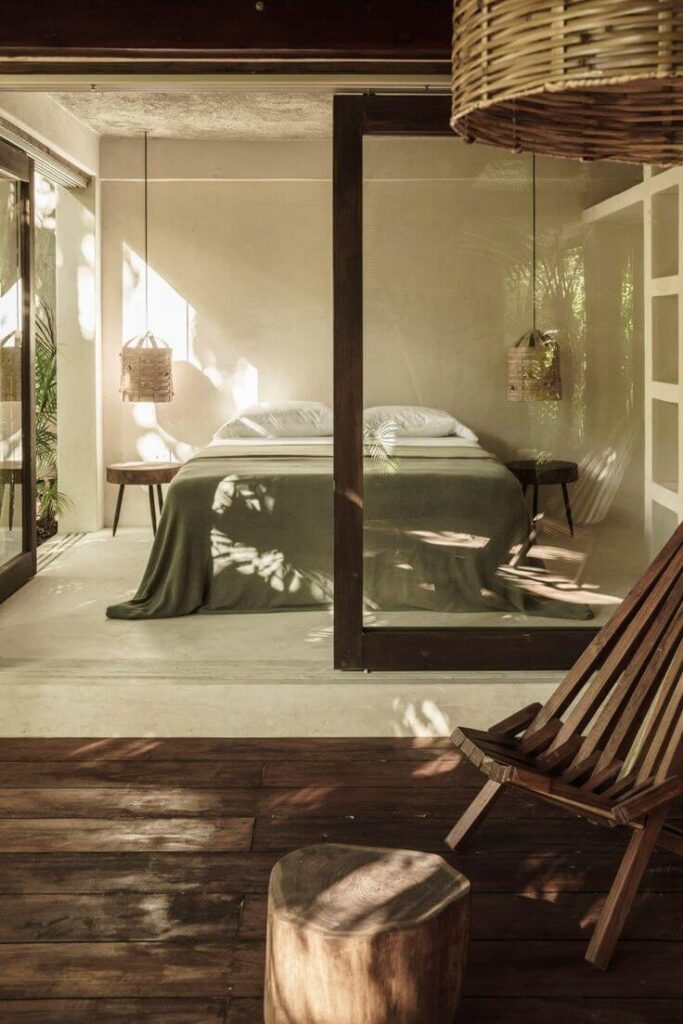
Incorporate aspects of Biophilic design into your bedroom.
“Biophilic design is a concept used within the building industry to increase occupant connectivity to the natural environment through the use of direct nature, indirect nature, and space and place conditions.” Biophilic aspects can include natural light, plants, and a layered theme of natural textures that come together to create an overall habitat of nature. Biophilic design creates visual impact, adds elements of nature (and a subtle pop of color) without taking up a lot of physical space and is deeply supportive of human health and wellbeing.
Beds are often a statement piece of bedrooms.
Platform beds layered with soft neutrals are ideal for a minimalist bed design and should be as comfortable as they look with dreamy textiles and a quality mattress. Incorporate layers of texture to create visual interest while letting the eyes soften into the room upon entrance. Ornate bed frames, sharp corners, and bright colors should be avoided if opting for a soft and warm minimalist space in the bedroom.
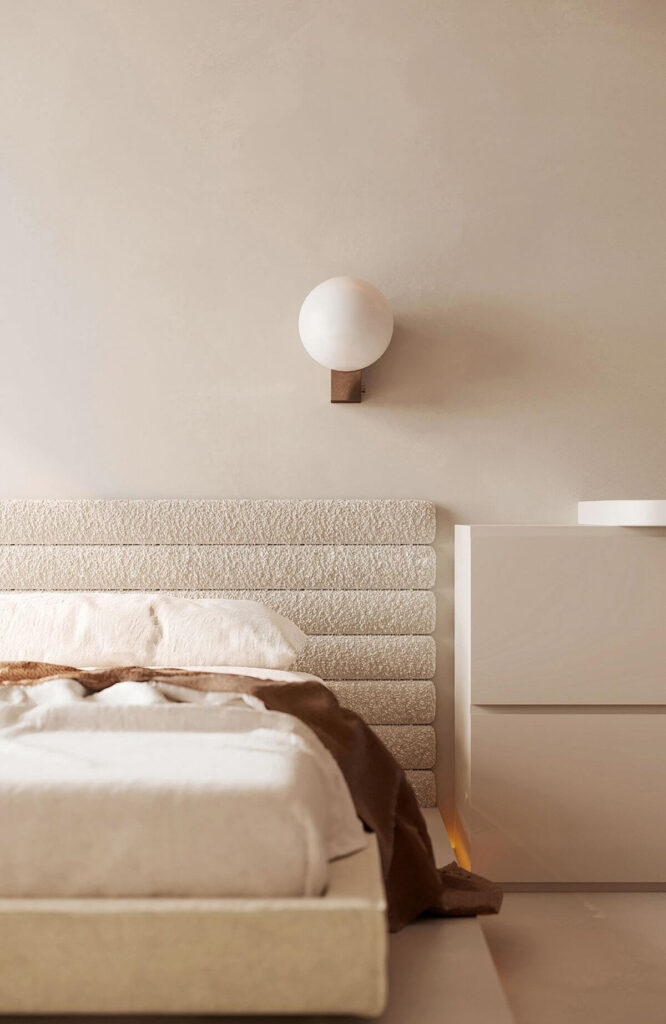
Statement Lighting
Statement lighting can be both visually impactful and supportive of well-being. There is nothing that kills ambiance faster than bad lighting. Lighting affects our hormones, and the ability to relax and to fall asleep. Avoid fluorescent bulbs, and bright white lighting in bedrooms and replace with soft, warm undertone lighting in both lamps and ceiling lighting. Lighting can make or break a room in many ways.
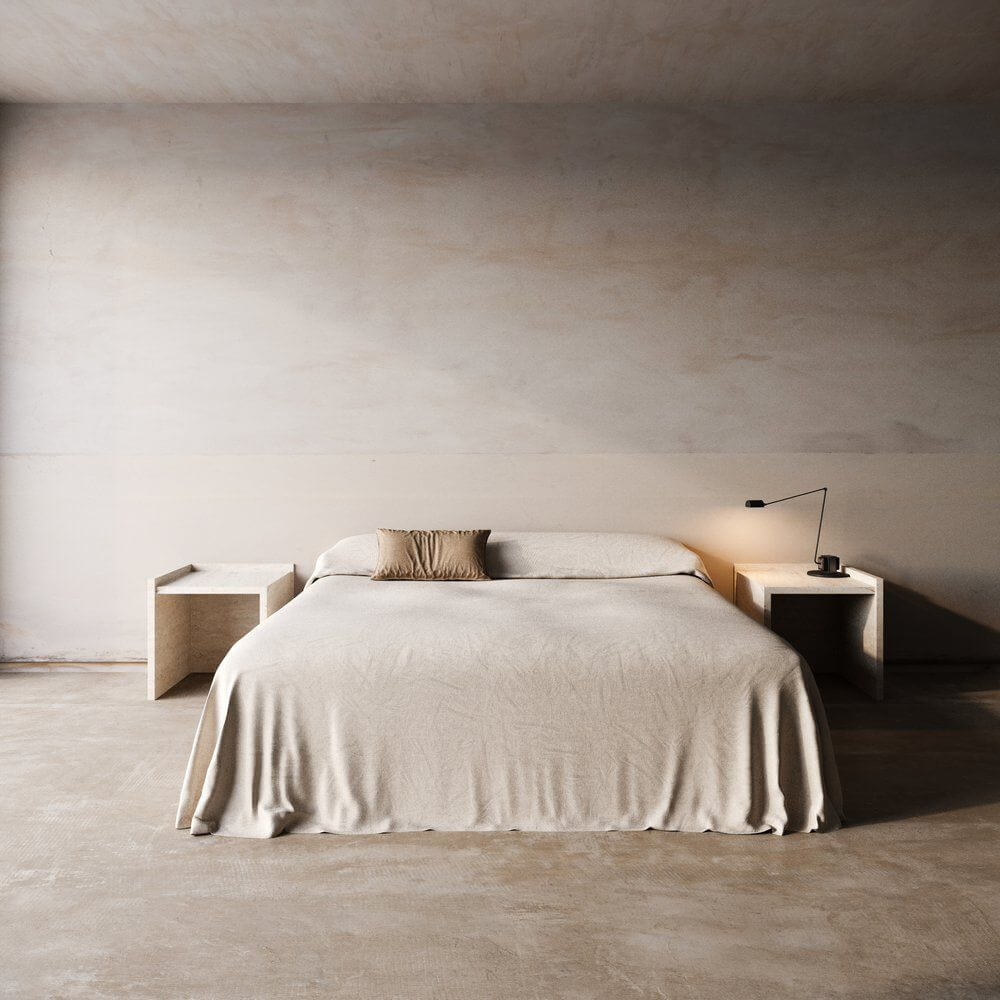
Subtle Accent Wall
A subtle accent wall is a beautiful way to create a statement and in some cases, add a layer of texture to your minimalist bedroom without adding physical items to the room. You can opt for wallpaper with a soft and subtle design or explore wall textures such as limewash paints that offer a nuanced, naturally unfinished layer of texture to a wall.
10 Minimalist Bedroom Ideas
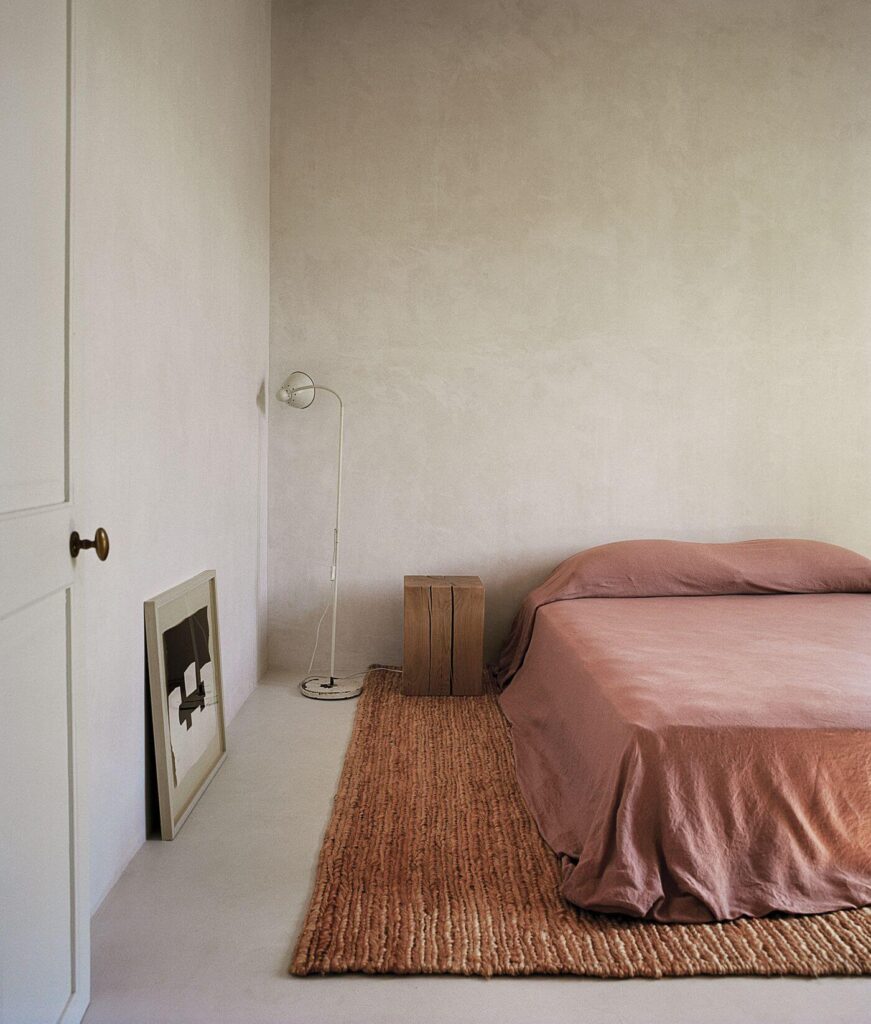
Keep bedside tables free of surface and drawer clutter.
I prefer side tables with no drawers to support this principle. Try not to use it under the bed as storage and eliminate electronic devices and things plugged in around your bed. These concepts each support a free-flowing and harmonious energy free of clutter around us as we sleep.
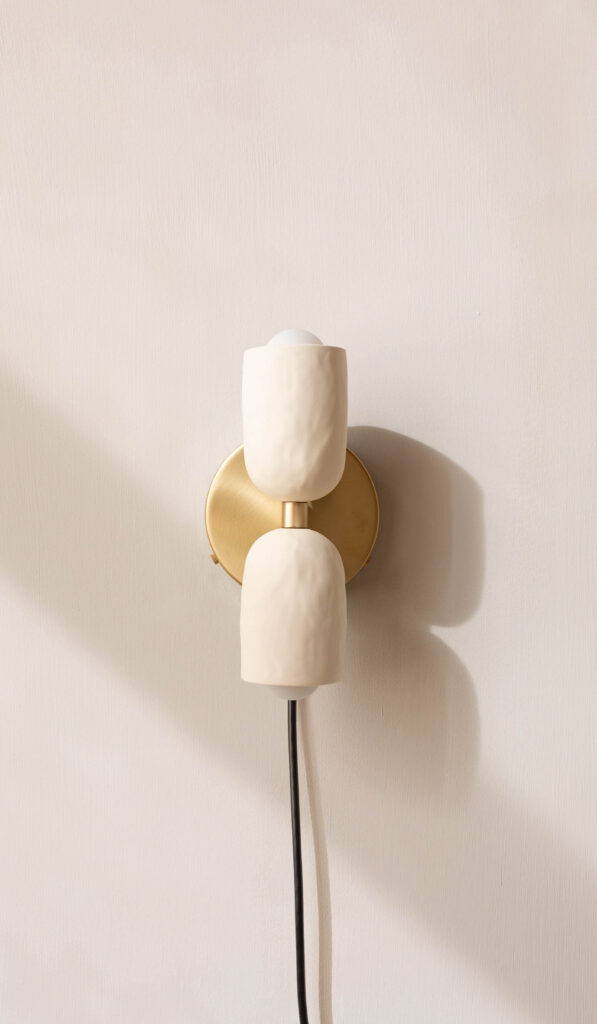
Pendant Lights and Wall Sconces
Hanging pendant lights and wall sconces are a great way to free up surface space on bedside tables, or anywhere really, while also serving as stylish statement pieces. If you are unable to add permanent light fixtures, say you’re in a rental or electrical wiring isn’t conducive, you can opt for plug-in wall sconces or pendant lights attached with brackets. I love the way the cord here plays into a simple black-and-white theme.
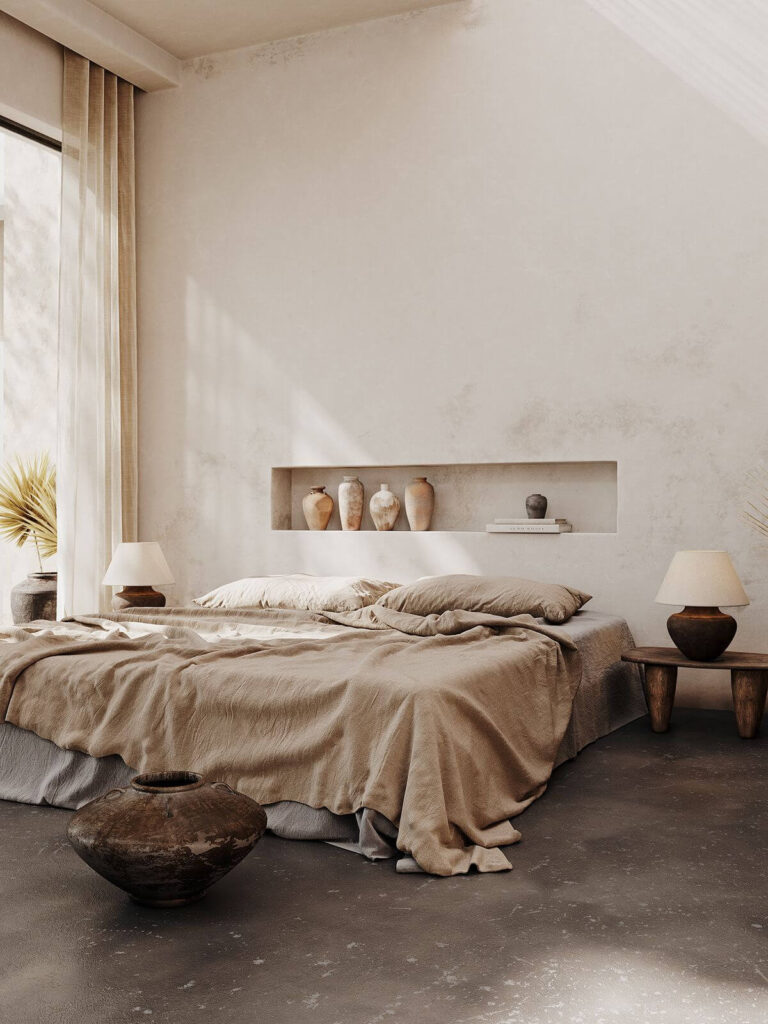
If any room in your home should be neutral, let it be the bedroom.
A neutral color palette and muted shades like white, beige, or tan will support the eye in softening the room vs. trying to figure out where to land, inviting peace and calm upon entering. Thread your neutral color scheme throughout various textures to create dimension and depth. Neutrals only become boring when they are flat.
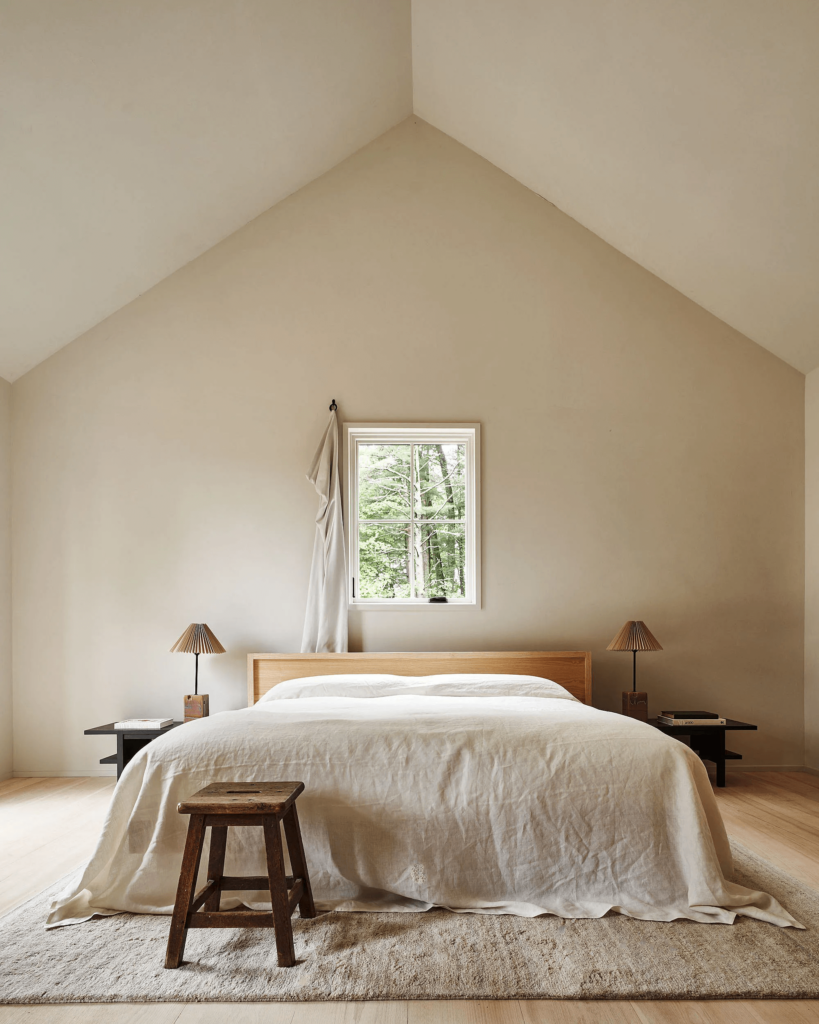
Keep the walls bare or as simple as possible.
Save the gallery walls for hallways and living room areas. Opt for 1 statement wall piece or keep them open. This again supports the eye softening into the space upon entrance.
Avoid too many mirrors in the bedroom and be sure to place them correctly when adding to a room.
Mirrors amplify the energy in a space so keep them to a minimum in the bedroom and never hang mirrors over the bed. It creates a heavy and activating energy over us while we sleep.

Use dishes and ceramics to display jewelry.
This keeps beautiful pieces front and center where we are more likely to use them and the dishes make for details that are both stylish and serve a purpose.
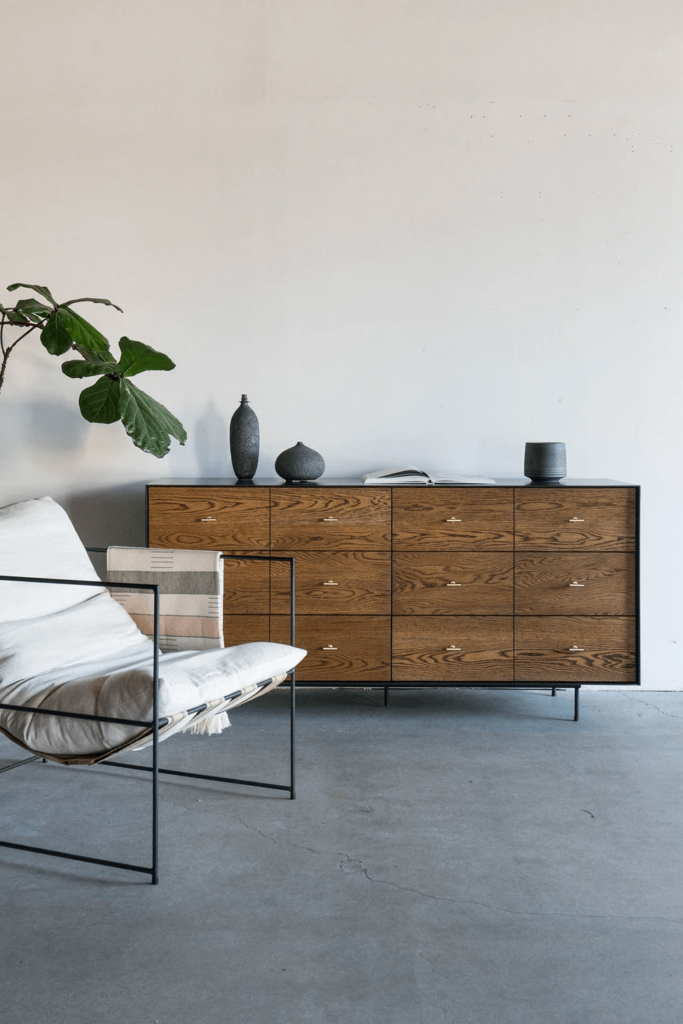
Scale furniture correctly for your room.
Bulky dressers and armoires are oftentimes just that, bulky without a purpose, and usually do not offer more storage space than lighter and minimal pieces of furniture. Both Scandinavian and Mid-century-influenced bedroom furniture are great options to seek out. You’ll often find clean lines and simple legs which help prevent furniture from adding bulk to a room.
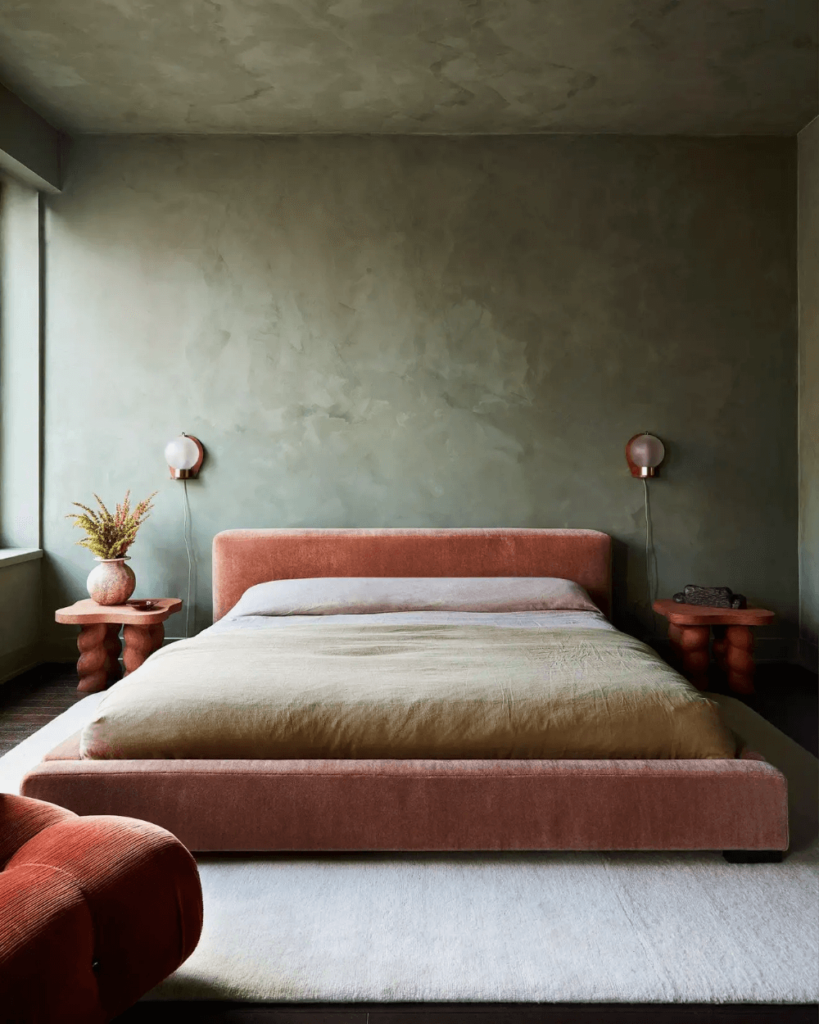
Rugs are an amazing way to add layers, textures, and style to a room.
Opt for oversized rugs to keep the space open and fuse in elements of warm minimalism. Smaller rugs and rugs with busy patterns will close the room in and draw the eye down. This rug, textured platform bed, and accent wall are a stunning combination of elements that prove a warm, minimalist approach is anything but boring or cold.
The round light fixtures also fuse softness into the details.
Round shapes lessen sharpness throughout spaces.
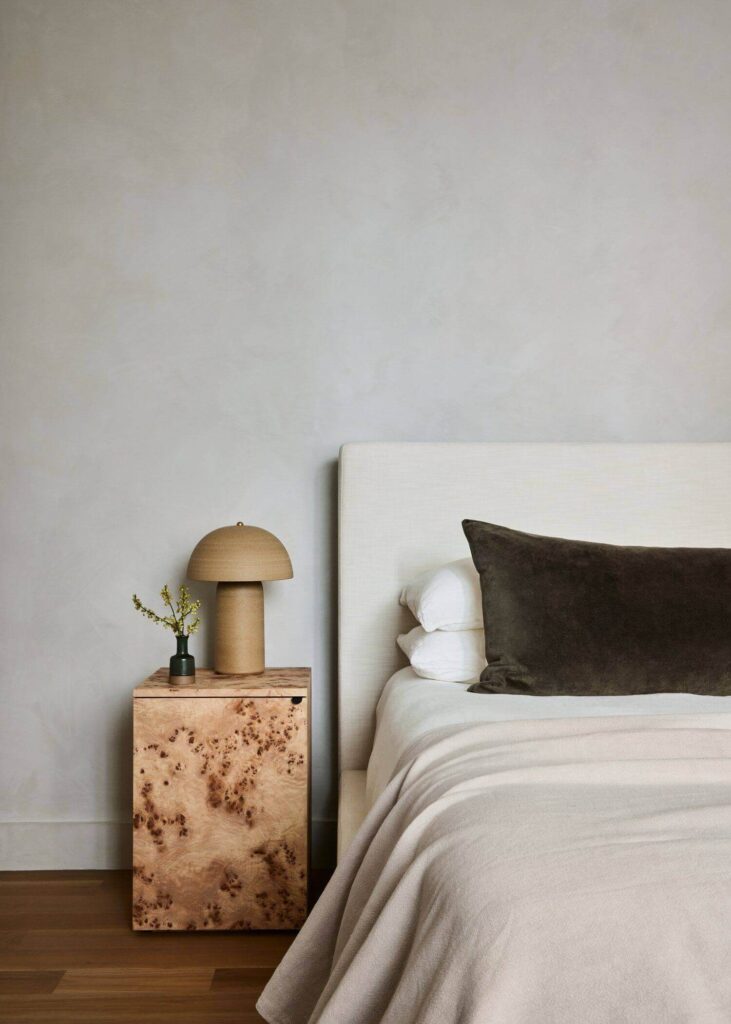
Last but not least, keep a low profile.
As you observe the photos shared throughout this post, you’ll notice your eye hovers at mid-level. Excess floor-to-ceiling items, especially if there are competing statement pieces in the mix will bounce the eye all over the room in order to decipher where to land. Keeping the focus and statement of bedrooms at mid to lower levels offers a reprieve for the eyes upon entering.
Well, there you have it! I hope this post has offered you inspiration and a fresh perspective on how a minimalist bedroom approach can be warm, soft, inviting, and anything but cold while supporting our well-being.
